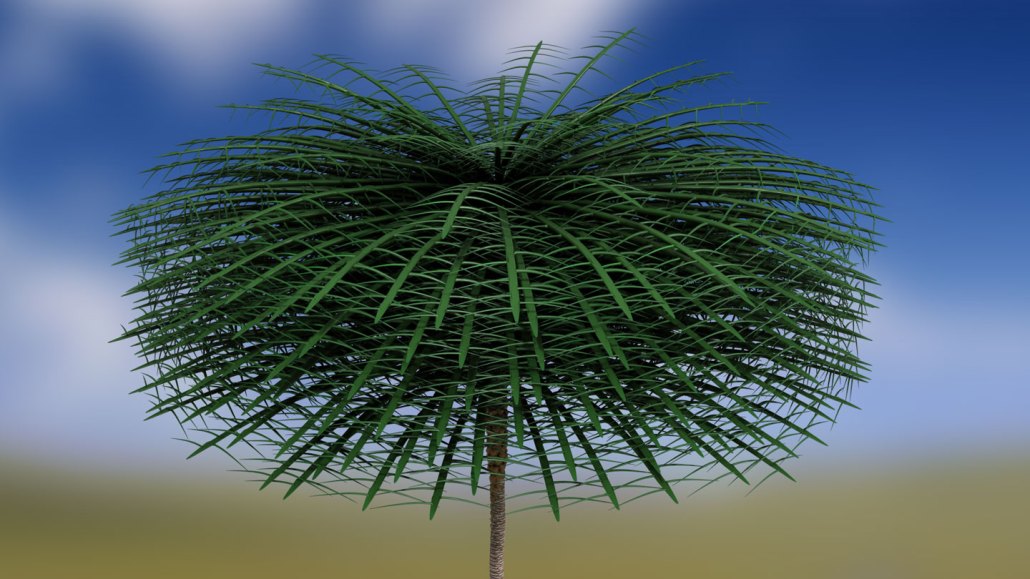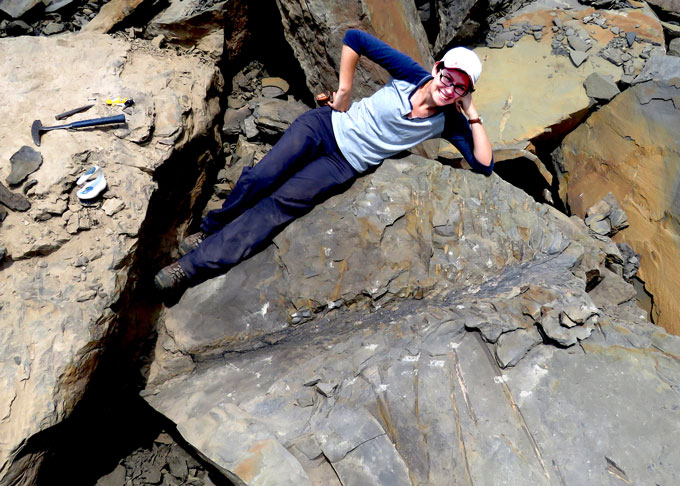A rare 3-D tree fossil may be the earliest glimpse at a forest understory
The 350-million-year old Seussian-looking tree had a mop-top crown wider than it was tall

After toppling to the bottom of an ancient lake, a Sanfordiacaulis densifolia tree was preserved in exquisite 3-D, allowing researchers to create this digital rendering of its spiraling crown.
Tim Stonesifer
With its fluffed, spiraling top and thin trunk, the Sanfordiacaulis densifolia tree looks like it came straight out of Dr. Seuss’ The Lorax. But this isn’t a truffula come to life. It’s a 3-D rendering of a 350 million-year-old fossil that shows something very few other fossils in the world ever have — both a trunk and the leaves of a tree species from a somewhat fuzzy time period in plant history, researchers report February 2 in Current Biology.
“When I first saw [the fossil], I was gobsmacked,” says geologist Robert Gastaldo of Colby College in Waterville, Maine. “Finding this … it made me think we should buy lottery tickets. That’s how rare it is.”
Over the past seven years, researchers have found five specimens of S. densifolia — all of which come from what was once a lake in New Brunswick, Canada. These trees lived during a time period known as the early Mississippian when little is understood about prehistoric plants. The short height of this new fossil, preserved with both a trunk and crown, suggests Mississippian forests may have had more layers than previously known. Not only is this the most complete tree fossil to be dated to this time period, but it is one of few fossils like this ever found across any geologic era.
“This is something remarkable,” says botanist Mihai Tomescu of California State Polytechnic University, Humboldt, who was not involved in this study. “It fills a gap within our picture of what forest structure looked like in the Mississippian.”

An earthquake probably broke these trees off at their bases, sending them rolling to the bottom of a nearby lake where they were later preserved, the researchers say. But when this recently discovered specimen fell, it wasn’t flattened like many other fossils. “This tree was preserved in almost complete three dimensionality,” says Patricia Gensel, a biologist at the University of North Carolina at Chapel Hill. “The leaves are very much intact, and that’s highly unusual.”
Using the fossil and a computer graphics program called Blender, the researchers created a 3-D digital reconstruction of what they think the tree would have looked like. It was only about half the height of a full-grown giraffe, but its crown was large, possibly as wide as 6 meters with leaves as long as 3 meters, the researchers estimate. They don’t yet know if this tree was fully mature, but they don’t think it would have ever neared the height of the other known trees from the Mississippian, which might have been upwards of 20 meters.
The combination of the tree’s mid-sized height and massive leaves lead researchers to believe S. densifolia could be the earliest known evidence of a subcanopy tree, which would have created a layered forest. Trees trying to live in the subcanopy would have had to adapt, in this case, by using large leaves to capture as much sunlight as possible. This new forest layer would have also altered the ecosystems around it by creating shelter and humidity, by shading sunlight and trapping evaporating groundwater. The creation of this kind of understory would have created new ecosystems for other organisms to exploit, creating more biodiversity, Gestaldo says.
More fossils of S. densifolia could help researchers better understand how plants adapted long ago. “Knowing about the changes that have taken place in plants through time helps us understand how plants may modify themselves to survive in the future,” Gensel says.







